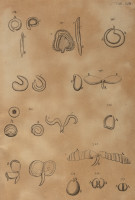Plant seeds
Date
1674
Creator
Marcello Malpighi (1628 - 1694, Italian) , Physician
Object type
Archive reference number
Manuscript page number
p151r
Material
Dimensions
height (page): 319mm
width (page): 225mm
width (page): 225mm
Subject
Content object
Description
Sectional views of various impregnated plant seeds viewed under magnification, including:
Figure 314 [upper left]: Beetroot, Beta vulgaris subsp, referred to by Malpighi as Beta.
Figure 315 [upper centre]: Unidentified species referred to as Gittagine.
Figure 316 [upper right]: Prickly pear, Opuntia, referred to as the same.
Figure 317 [centre right]: Calendula, referred to as the same.
Figure 318 [centre left]: Vesicaria, referred to as the same.
Figure 319 [centre right]: Radish, Raphanus sativus, referred to as Raphano.
Figure 320 [lower right]: Poppy, Papaver, referred to as Opio.
Figure 321 [lower right]: Apple tree, Malus domestica, pear tree, Pyrus, marrow, Cucurbita, and more, referred to as Pomorum, Pirorum, and Cucurbita respectively.
Figure 322 [lower right]: Legumes, Fabaceae, referred to as Fabis.
Figure 323 [lower right]: Bay tree, Laurus, referred to as Lauro.
Each drawn on an individual slip of paper and arranged on the page for printing. Inscribed: ‘Tab LIII’ in top right-hand corner.
Page 151 from MS/103/1, later published as Tab. LIII in Marcello Malpighi's Anatome plantarum (1675).
Marcello Malpighi (1628-1694), Italian biologist and physician, was elected a Fellow of the Royal Society in 1669.
Figure 314 [upper left]: Beetroot, Beta vulgaris subsp, referred to by Malpighi as Beta.
Figure 315 [upper centre]: Unidentified species referred to as Gittagine.
Figure 316 [upper right]: Prickly pear, Opuntia, referred to as the same.
Figure 317 [centre right]: Calendula, referred to as the same.
Figure 318 [centre left]: Vesicaria, referred to as the same.
Figure 319 [centre right]: Radish, Raphanus sativus, referred to as Raphano.
Figure 320 [lower right]: Poppy, Papaver, referred to as Opio.
Figure 321 [lower right]: Apple tree, Malus domestica, pear tree, Pyrus, marrow, Cucurbita, and more, referred to as Pomorum, Pirorum, and Cucurbita respectively.
Figure 322 [lower right]: Legumes, Fabaceae, referred to as Fabis.
Figure 323 [lower right]: Bay tree, Laurus, referred to as Lauro.
Each drawn on an individual slip of paper and arranged on the page for printing. Inscribed: ‘Tab LIII’ in top right-hand corner.
Page 151 from MS/103/1, later published as Tab. LIII in Marcello Malpighi's Anatome plantarum (1675).
Marcello Malpighi (1628-1694), Italian biologist and physician, was elected a Fellow of the Royal Society in 1669.
Object history
Marcello Malpighi’s research on the anatomy of plants was encouraged and supported by the Royal Society, as evidenced by correspondence between him and the then-Secretary, Henry Oldenburg FRS (1619-1677) in the 1660s and 1670s [MS/103/1].
An abstracted version of his work in this area was first read at a Society meeting on 7 December 1671 [JBO/4, pp.216-217]. The full manuscript of Anatome Plantarum, together with the frontispiece artwork and these plates, was received and read on 28 January 1674/75 [MS/103/1-2].
It was ordered for printing by the Society’s printer John Martin in June 1675 [CMO/1/221]. The published work consists of the text of Anatome Plantarum and De ovo incubato as an appendix, and 61 plates illustrating each [54 and 7 respectively].
An abstracted version of his work in this area was first read at a Society meeting on 7 December 1671 [JBO/4, pp.216-217]. The full manuscript of Anatome Plantarum, together with the frontispiece artwork and these plates, was received and read on 28 January 1674/75 [MS/103/1-2].
It was ordered for printing by the Society’s printer John Martin in June 1675 [CMO/1/221]. The published work consists of the text of Anatome Plantarum and De ovo incubato as an appendix, and 61 plates illustrating each [54 and 7 respectively].
Related fellows
Marcello Malpighi (1628 - 1694, Italian) , Physician
Associated place
